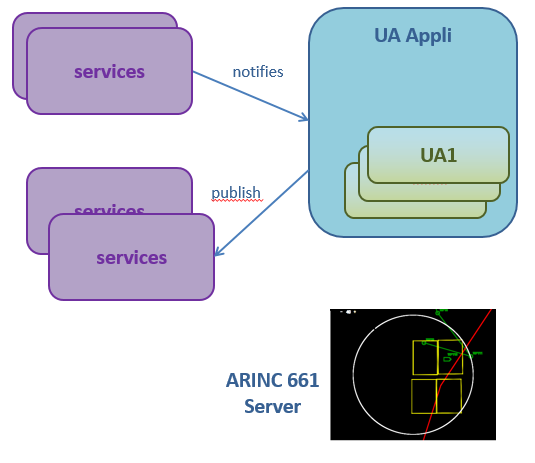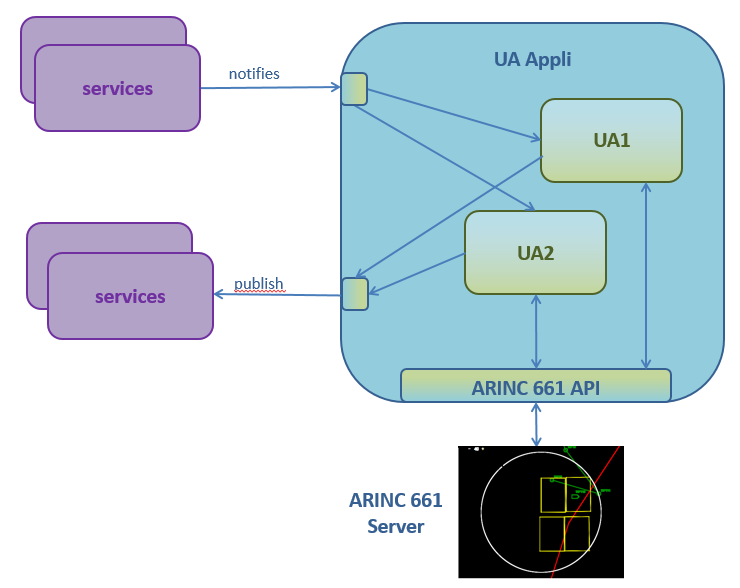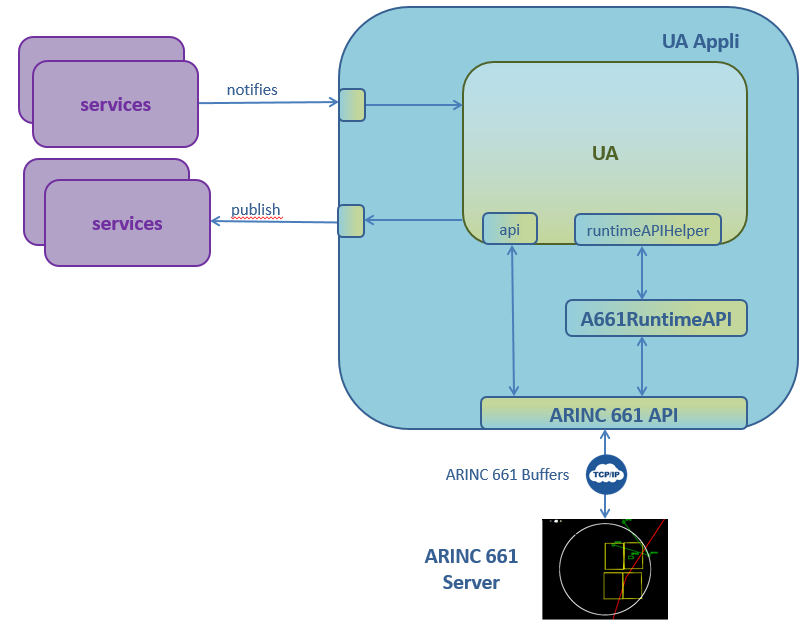Home
Categories
Dictionary
Glossary
Download
Project Details
Changes Log
What Links Here
FAQ
License
UA application
1 About ARINC 661
2 Architecture
3 Services
3.1 Declaring widget events
4 Properties
4.1 Mandatory properties
4.2 A661 configuration
4.3 UA configuration
4.4 Optional properties
4.5 ConnectionDelay property
4.6 Properties file examples
5 Setting the User Application configuration
6 Developing the UAs
6.1 Using the ARINC 661 API
7 Using the ARINC 661 API for Maps
7.1 ProjectionHelper
8 WindowHelper
9 Tutorials
10 Notes
11 See also
2 Architecture
3 Services
3.1 Declaring widget events
4 Properties
4.1 Mandatory properties
4.2 A661 configuration
4.3 UA configuration
4.4 Optional properties
4.5 ConnectionDelay property
4.6 Properties file examples
5 Setting the User Application configuration
6 Developing the UAs
6.1 Using the ARINC 661 API
7 Using the ARINC 661 API for Maps
7.1 ProjectionHelper
8 WindowHelper
9 Tutorials
10 Notes
11 See also
| Function | get parameters from a Joystick |
| Distribution | UAAppli-bin- |
| Jar files | UAApplication.jar |
| Modules | uaappli |
| Provided services | through module configuration |
| Required services | through module configuration |
| Mandatory properties | a661ConfiguaConfig or uaImpl and uaPath or script |
| Optional properties | includeServeruaServerConfigdefaultSubscribeServicedefaultSubscribeURIdefaultProvideServicedefaultProvideURIconnectionDelaydebug |
The built-in UA application allows to execute an ARINC 661 Client (and optionally its associated Server). Note that several UAs can be hosted in the UA application, all sharing the same API.
Note that the UA Application module is a wrapper around an ARINC 661 server and client, provided by the J661 project. Go to j661.sourceforge.net for more information.
ARINC 661 is a standard which aims to normalize the definition of a Cockpit Display System (CDS), and the communication between the CDS and User Applications (UA) which manage Aircraft avionics functions. The GUI definition is completely defined in binary Definition Files (DF). The CDS software is constituted of a kernel which is able to create the GUI hierarchy specified in the DF during initialization, thus not needing to be recompiled if the GUI definition changes.

The UA application acts as a proxy for the UAs it hosts:

The UA Application has several mandatory and optional properties.
The ARINC 661 configuration file is specified by the
There are several ways to define the UA configuration:
If you want the
For example:
There are two ways to develop a UA:
There are two ways to use the ARINC 661 API:

Map widgets are widgets which allow to manage digital maps, with mission-specific runtime overlays such as Flight Plans, Radar plots and targets, etc...
The elements which are shown in Maps are called MapItems. They are not widgets whith a position defined in 100th of mm but are defined only at runtime in a real-world coordinate system (for example Latitude and Longitude).
The
The
Several tutorials explain step by step how to develop and configure UAs. See UA application tutorials.
Note that the UA Application module is a wrapper around an ARINC 661 server and client, provided by the J661 project. Go to j661.sourceforge.net for more information.
About ARINC 661
Main Article: ARINC 661
ARINC 661 is a standard which aims to normalize the definition of a Cockpit Display System (CDS), and the communication between the CDS and User Applications (UA) which manage Aircraft avionics functions. The GUI definition is completely defined in binary Definition Files (DF). The CDS software is constituted of a kernel which is able to create the GUI hierarchy specified in the DF during initialization, thus not needing to be recompiled if the GUI definition changes.
Architecture
The built-in UA application host one or several UAs, and optionnally also manage a Server.
The UA application acts as a proxy for the UAs it hosts:
- Notifications from subscribed framework services are passed on the UAs
- Services invocations executed by UAs are send through the framework
- Messages from / to the ARINC 661 Server are passed from the UA application to the UAs

Services
Only the services for which the UA Application Module is a provider or subscriber will be taken into account[1]
There are no limitations on the types of services which can be provided or subscribed by the UA Application
. For example:<interfaces> <subscribe service="aircraft" /> <subscribe service="scenario" /> <subscribe service="caslist" /> <eventSend service="casactions" /> </interfaces>Note that as it is allowed for a Module to be both a provider and a subscriber of a Service, it is possible to use this in the UA Application module to notify an UA from a Service invocation from another UA.
Declaring widget events
To avoid to have to declare one service for each widget event, you can use a union type to declare all the events for one Layer, and even specify the union type as an anonymous type. This way you will have only one service for all GUI widget events. For example:<services> <event name="guiEvent" > <data name="event"> <unionType variant="int" > <member name="button1" type="nil" /> <member name="button2" type="nil" /> <member name="toggle1" type="bool" /> <member name="toggle2" type="bool" /> </structType> </data> </event> </services>And the code to invoke the Service would be for a button:
api.addWidgetEventListener(LAYER, PUSH_BUTTON, new ARINCEventListener() { public void eventReceived(ARINCEvent evt) { WidgetEvent widgetEvt = (WidgetEvent) evt; try { Data.Union data = (Data.Union)eventService.getData("event"); data.setMemberValue("button1"); eventService.invoke(); } catch (ARINCRuntimeException ex) { logger.error(module, ex.getMessage()); } } });And for a toggle:
api.addWidgetEventListener(LAYER, TOGGLE_BUTTON, new ARINCEventListener() { public void eventReceived(ARINCEvent evt) { WidgetEvent widgetEvt = (WidgetEvent) evt; try { Data.Union data = (Data.Union)eventService.getData("event"); boolean isSelected = ((Boolean) widgetEvt.getValues().get(0)); data.setMemberValue("toggle1", isSelected); eventService.invoke(); } catch (ARINCRuntimeException ex) { logger.error(module, ex.getMessage()); } } });
Properties
Main Article: UA configuration
The UA Application has several mandatory and optional properties.
Mandatory properties
-
a661Config: the file specifying the ARINC 661 configuration for the UA Client and the Server. Note that if thea661ServerConfigis specified, the Server will have a separate ARINC configuration from the UA. See a661Config for more information -
uaConfig, oruaImplanduaPath, orscript: the path for the UAs hosted by the UA Application
A661 configuration
Main Article: a661Config
The ARINC 661 configuration file is specified by the
a661Config property (and optionally the a661ServerConfigproperty ), and has the format specified in the ARINC 661 project. See the a661Config article of the J661 project documentation for more information on how to configure a J661 Server.
UA configuration
Main Article: UA configuration
There are several ways to define the UA configuration:
-
uaImplanduaPath: used when there is only one Java UA hosted by the UA Application. See Using the uaImpl and uaPath properties -
script: used when there is only one Groovy scripted UA hosted by the UA Application. See Using the script property -
uaConfig: used when there are more than one UA hosted by the UA Application. See Using the uaConfig property
Optional properties
-
a661ServerConfig: the file specifying the separate ARINC 661 configuration for the Server -
includeServer: (default is true) true if the Server must also be started with the UA Application -
defaultSubscribeService: the name of the default subscribed service -
defaultProvideService: the name of the default provided service -
connectionDelay: the delay to all the FunctionalUA.connected() method for the UA -
debug: boolean which allows to print additional messages if there is an error when using the Functional UA runtime API
ConnectionDelay property
By default the FunctionalUA.connected() method for each UA is called as soon as the module is started and the network connected.If you want the
connected() to be called after a delay, you can specigfy it by setting the connectionDelay property. This can be useful for UDP connections when you might have a server connected after the UA. THis peroperty can be defined globally for all your UAs or for each UA.For example:
<properties> <application name="uaappli" > <module name="uaappli" > <moduleProperty key="uaImpl" value="UATutorial.jar" /> <moduleProperty key="uaPath" value="org.da.protoframework.tutorial.uaappli.UATutorial" /> <moduleProperty key="a661Config" value="a661/tutorial.properties" /> <moduleProperty key="includeServer" value="false" /> <moduleProperty key="connectionDelay" value="2s" /> </module> </application> </properties>
Properties file examples
Setting the User Application configuration
In the following case, we do not include the Server:<properties> <application name="uaappli" > <module name="uaappli" > <moduleProperty key="uaImpl" value="UATutorial.jar" /> <moduleProperty key="uaPath" value="org.da.protoframework.tutorial.uaappli.UATutorial" /> <moduleProperty key="a661Config" value="a661/tutorial.properties" /> <moduleProperty key="includeServer" value="false" /> </module> </application> </properties>In this next case, we include the Server:
<properties> <application name="uaappli" > <module name="uaappli" > <moduleProperty key="uaImpl" value="UATutorial.jar" /> <moduleProperty key="uaPath" value="org.da.protoframework.tutorial.uaappli.UATutorial" /> <moduleProperty key="a661Config" value="a661/tutorial.properties" /> <moduleProperty key="includeServer" value="true" /> </module> </application> </properties>In this last case, we include the Server but we use a separate ARINC 661 configuration for the Client and the Server:
<properties> <application name="uaappli" > <module name="uaappli" > <moduleProperty key="uaImpl" value="UATutorial.jar" /> <moduleProperty key="uaPath" value="org.da.protoframework.tutorial.uaappli.UATutorial" /> <moduleProperty key="a661Config" value="a661/tutorialClient.properties" /> <moduleProperty key="a661ServerConfig" value="a661/tutorialServer.properties" /> <moduleProperty key="includeServer" value="true" /> </module> </application> </properties>
Developing the UAs
Main Article: Developing a UA
There are two ways to develop a UA:
- As an UA coded in Java
- As a Scripted UA coded in Groovy
And even interact between themselves through Services as any Module. It is allowed and it is not an error for a Module to be both a provider and subscriver of a Service. See also being both a provider and a subscriber of a Service
. Several tutorials explain step by step how to develop and configure UAs. See UA application tutorials for more information.
Using the ARINC 661 API
See also ARINC 661 client API and Functional UA runtime API
There are two ways to use the ARINC 661 API:
- By directly using the
apiinstance which is the ARINC 661 client API allowing to communicate with the ARINC661 server - By using the
runtimeAPIHelperinstance provided in the FunctionalUA which simplify the usage of the API (see Functional UA runtime API for more information)

Using the ARINC 661 API for Maps
Main Article: Using UAAppli Application for Maps
Map widgets are widgets which allow to manage digital maps, with mission-specific runtime overlays such as Flight Plans, Radar plots and targets, etc...
The elements which are shown in Maps are called MapItems. They are not widgets whith a position defined in 100th of mm but are defined only at runtime in a real-world coordinate system (for example Latitude and Longitude).
ProjectionHelper
Main Article: UA ProjectionHelper
The
UAAppliHelper.jar library contains a ProjectionHelper class allowing to:- get the bearing of the vector of two MapItems
- get the East/North position of a MapItem knowing its Latitude/Longitude
- get the Latitude/Longitude of a MapItem knowing its East/North position in nautical miles
- get the Latitude/Longitude of a MapItem knowing its position in 100th of mm
WindowHelper
Main Article: UA WindowHelper
The
UAAppliHelper.jar library contains a WindowHelper class allowing to get the native Windows on the machine on which the framework is running.
Tutorials
Main Article: UA application tutorials
Several tutorials explain step by step how to develop and configure UAs. See UA application tutorials.
Notes
- ^ There are no limitations on the types of services which can be provided or subscribed by the UA Application
- ^ And even interact between themselves through Services as any Module. It is allowed and it is not an error for a Module to be both a provider and subscriver of a Service. See also being both a provider and a subscriber of a Service
- ^ See the UA ProjectionHelper or UA WindowHelper articles for more information
See also
- UA application dependencies: This article is about the libraries dependencies of the UA application module
- ARINC 661 glossary: This article presents the concepts defined in the ARINC 661 standard, used in the UA Application built-in application
- UA application tutorials: This article presents the tutorials for developing User Applications (UA)
- ARINC 661 client API: This article explains how to use the ARINC 661 Client API in the built-in UA Application module
- Functional UA runtime API: This article explains how to use the methods in the Functional UA which simplify the usage of the ARINC 661 API
- Built-in Applications: This article present the built-in Applications distributed with the framework
×
![]()
Categories: builtin-applis | uaappli